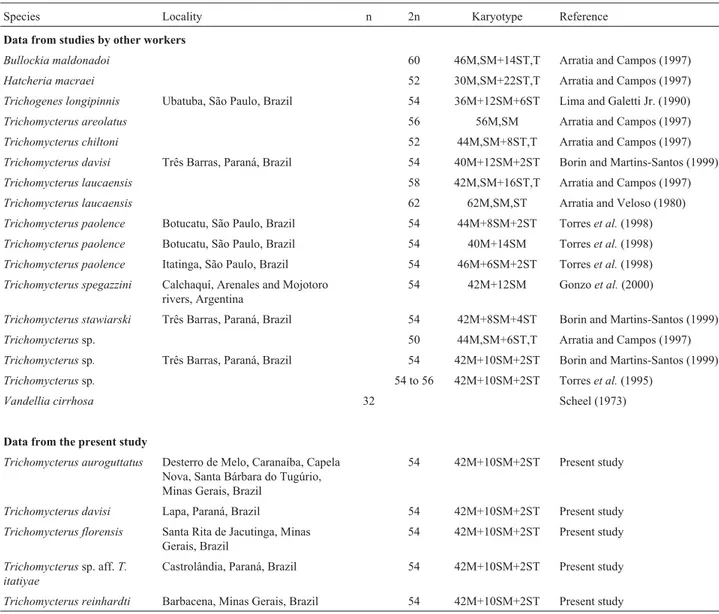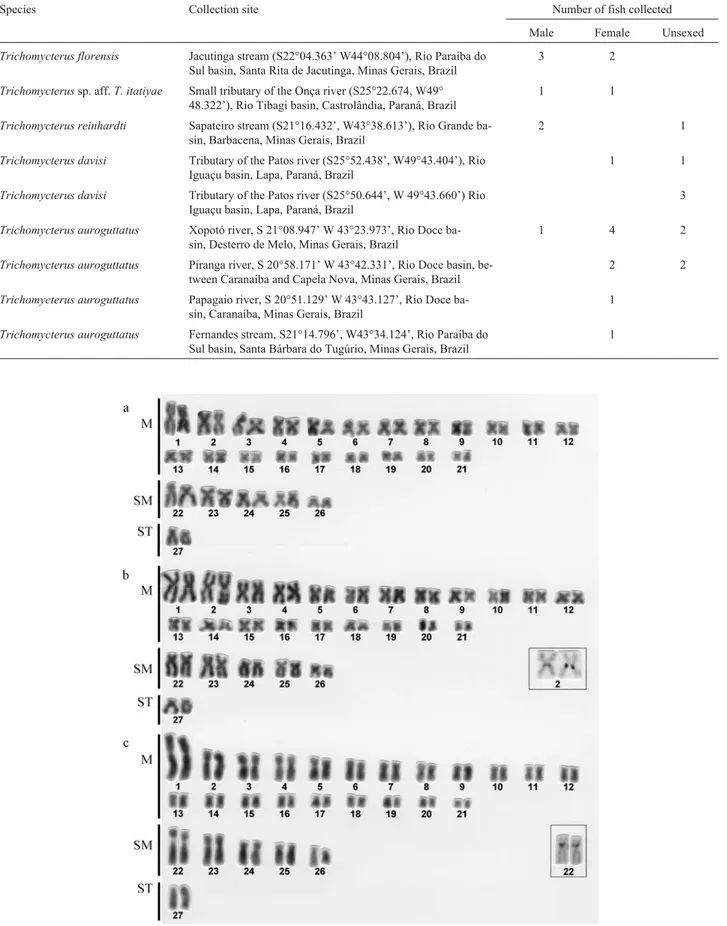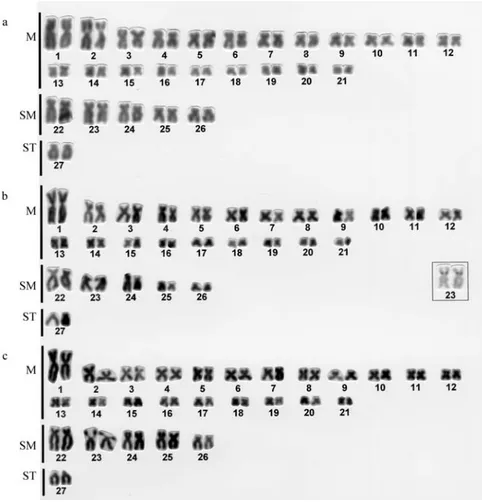Karyotype description of five species of
Trichomycterus
(Teleostei: Siluriformes: Trichomycteridae)
Luciana Ramos Sato, Claudio Oliveira and Fausto Foresti
Universidade Estadual Paulista, Instituto de Biociências, Departamento de Morfologia,
Botucatu, SP, Brazil.
Abstract
Trichomycteridae is a family of small catfish which are widely distributed throughout Southern Central America and South America. The present study showed that the cis-Andean speciesTrichomycterus florensis, Trichomycterus sp. aff.Trichomycterus itatiyae, Trichomycterus reinhardti, Trichomycterus davisi and Trichomycterus auroguttatus had 2n = 54 chromosomes (42 metacentric, 10 submetacentric and 2 subtelocentric), with T. reinhardti, T. auroguttatus and T. sp. aff. T. itatiyae exhibiting only one chromosome pair with silver-stained nucleolus organizer regions (NORs). The cytogenetic data suggest the existence of at least two groups of species in the cis-Andean representatives of the genusTrichomycterus. In the first group the first metacentric pair is considerably larger than the second metacentric pair and the NORs occur in the pericentromeric position of the short arm of a large submetacentric pair while in the second group the first and second metacentric pairs are about the same size and larger than the other metacentric pairs and the NORs are located in the pericentromeric position of the long arm of a large metacentric pair. The relative conservatism of the karyotype of the cis-Andean Trichomycterus species contrasts with the wide diversification observed in the trans-Andean species, reinforcing the hypothesis that the genus is not monophyletic.
Key words:chromosome evolution, NOR banding, fish.
Received: January 6, 2003; Accepted: November 27, 2003.
Introduction
Trichomycteridae is a family of small-sized catfish which are widely distributed throughout Southern Central America and South America (Wosiacki, 2002). This family has 171 described species, distributed between 39 genera and eight subfamilies: Trichogeninae, Copionodontinae, Sarcoglanidinae, Glanapteryginae, Tridentinae, Vandelli-nae, StegophiliVandelli-nae, and Trichomycterinae (de Pinna and Wosiacki, 2003). According to de Pinna (1998), the Trichomycteridae is a monophyletic group because it ex-hibits seven synapomorphies, most of which are concen-trated in the opercular suspensory arch, a highly modified structure that enables fish to anchor on either the substrate or the tissue of their hosts. The subfamily Trichomycterinae is a non-monophyletic assemblage that currently includes eight genera and about 100 species (Wosiacki, 2002). How-ever, according to Mário C.C. de Pinna (personal commu-nication) a large number of new species are yet to be described in this genus.
Only a few cytogenetic studies of the family Tricho-mycteridae have been conducted, in spite of the large num-ber of species and the wide distribution of this family (Table 1). The diploid chromosome number ranges from 2n = 50 in aTrichomycterusspecies to 2n = 64 inVandellia cirrhosa(Table 1), although most species of this family have 2n = 54 chromosomes (Table 1).
In this paper we describe the karyotypes of five
Trichomycterusspecies collected from different Brazilian hydrographic basins and discuss the evolution of chromo-somes in the family Trichomycteridae.
Materials and Methods
FiveTrichomycterusspecies were analyzed, the spe-cies, collection site and number (male, female and unsexed) of specimens collected being shown in Table 2. The fish were identified and kept in the fish collection of Labora-tório de Biologia de Peixes (LBP), Instituto de Biociências, Universidade Estadual Paulista, Botucatu, São Paulo, Bra-zil.
Chromosome preparations and staining techniques, including silver-staining for the nucleolus organizer re-gions (NORs), were carried out according to Forestiet al. www.sbg.org.br
Send correspondece to C. Oliveira. Universidade Estadual Paulis-ta, Instituto de Biociências, Departamento de Morfologia, 18618-000 Botucatu, SP, Brazil. E-mail: claudio@ibb.unesp.br.
(1993). Chromosome morphology was determined on the basis of arm ratio as proposed by Levanet al.(1964) and chromosomes were classified as metacentric (M), submetacentric (SM) or subtelocentric (ST).
Results and Discussion
All the species analyzed in the present study exhib-ited 2n = 54 chromosomes: 42 metacentric, 10 submeta-centric and 2 subtelosubmeta-centric (Figures 1 and 2). Numeric polymorphisms, such as those described for
Trichomycterus paolence(Torreset al., 2002) andT. davisi
(Borin and Martins-Santos, 2000), were not detected in the species studied.
Karyotypic analysis of the samples showed that the first metacentric pair was considerably larger than the sec-ond metacentric pair in T. florensis (Figure 1a), T. reinhardti(Figure 1c) and all theT. auroguttatussamples (Figures 2b and 2c), this characteristic having also been
ob-served in two cytotypes ofT. paolence(Torreset al., 1998),
Trichomycterus spegazzini (Gonzo et al., 2000), and
Trichogenes longipinnis(Lima and Galetti Jr., 1990). Another common characteristic of theT. reinhardti
andT. auroguttatussampled was the presence of NORs in the pericentromeric position of the short arm of a large submetacentric pair (Figures 1c and 2b, respectively), this characteristic having also been described inT. spegazzini
(Gonzoet al., 2000).
InT.sp. aff.T. itatiyae(Figure 1b) andT. davisi (Fig-ure 2a) the first and the second metacentric pairs were about the same size and larger than the other metacentric pairs. This characteristic was also observed in the karyotypes of one T. paolence cytotype (Torres, 1998) and also in T. davisi,Trichomycterus stawiarskiandTrichomycterussp. (Borin and Martins-Santos, 1999).
We also identified NORs in the second metacentric pair ofT.sp. aff.T. itatiyaein the pericentromeric position
Table 1- Cytogenetic data for members of the family Trichomycteridae.
Species Locality n 2n Karyotype Reference
Data from studies by other workers
Bullockia maldonadoi 60 46M,SM+14ST,T Arratia and Campos (1997)
Hatcheria macraei 52 30M,SM+22ST,T Arratia and Campos (1997)
Trichogenes longipinnis Ubatuba, São Paulo, Brazil 54 36M+12SM+6ST Lima and Galetti Jr. (1990)
Trichomycterus areolatus 56 56M,SM Arratia and Campos (1997)
Trichomycterus chiltoni 52 44M,SM+8ST,T Arratia and Campos (1997)
Trichomycterus davisi Três Barras, Paraná, Brazil 54 40M+12SM+2ST Borin and Martins-Santos (1999)
Trichomycterus laucaensis 58 42M,SM+16ST,T Arratia and Campos (1997)
Trichomycterus laucaensis 62 62M,SM,ST Arratia and Veloso (1980)
Trichomycterus paolence Botucatu, São Paulo, Brazil 54 44M+8SM+2ST Torreset al.(1998)
Trichomycterus paolence Botucatu, São Paulo, Brazil 54 40M+14SM Torreset al.(1998)
Trichomycterus paolence Itatinga, São Paulo, Brazil 54 46M+6SM+2ST Torreset al.(1998)
Trichomycterus spegazzini Calchaquí, Arenales and Mojotoro rivers, Argentina
54 42M+12SM Gonzoet al.(2000)
Trichomycterus stawiarski Três Barras, Paraná, Brazil 54 42M+8SM+4ST Borin and Martins-Santos (1999)
Trichomycterussp. 50 44M,SM+6ST,T Arratia and Campos (1997)
Trichomycterussp. Três Barras, Paraná, Brazil 54 42M+10SM+2ST Borin and Martins-Santos (1999)
Trichomycterussp. 54 to 56 42M+10SM+2ST Torreset al.(1995)
Vandellia cirrhosa 32 Scheel (1973)
Data from the present study
Trichomycterus auroguttatus Desterro de Melo, Caranaíba, Capela Nova, Santa Bárbara do Tugúrio, Minas Gerais, Brazil
54 42M+10SM+2ST Present study
Trichomycterus davisi Lapa, Paraná, Brazil 54 42M+10SM+2ST Present study
Trichomycterus florensis Santa Rita de Jacutinga, Minas Gerais, Brazil
54 42M+10SM+2ST Present study
Trichomycterussp. aff.T. itatiyae
Castrolândia, Paraná, Brazil 54 42M+10SM+2ST Present study
Figure 1- Karyotypes of: a)Trichomycterus florensis; b)Trichomycterussp. aff.T. itatiyae; c)Trichomycterus reinhardti. The NOR-bearing chromo-some pairs are shown in the insets.
Table 2- Specimens used in the study presented in this paper.
Species Collection site Number of fish collected Male Female Unsexed
Trichomycterus florensis Jacutinga stream (S22°04.363’ W44°08.804’), Rio Paraíba do Sul basin, Santa Rita de Jacutinga, Minas Gerais, Brazil
3 2
Trichomycterussp. aff.T. itatiyae Small tributary of the Onça river (S25°22.674, W49° 48.322’), Rio Tibagi basin, Castrolândia, Paraná, Brazil
1 1
Trichomycterus reinhardti Sapateiro stream (S21°16.432’, W43°38.613’), Rio Grande ba-sin, Barbacena, Minas Gerais, Brazil
2 1
Trichomycterus davisi Tributary of the Patos river (S25°52.438’, W49°43.404’), Rio Iguaçu basin, Lapa, Paraná, Brazil
1 1
Trichomycterus davisi Tributary of the Patos river (S25°50.644’, W 49°43.660’) Rio Iguaçu basin, Lapa, Paraná, Brazil
3
Trichomycterus auroguttatus Xopotó river, S 21°08.947’ W 43°23.973’, Rio Doce ba-sin, Desterro de Melo, Minas Gerais, Brazil
1 4 2
Trichomycterus auroguttatus Piranga river, S 20°58.171’ W 43°42.331’, Rio Doce basin, be-tween Caranaíba and Capela Nova, Minas Gerais, Brazil
2 2
Trichomycterus auroguttatus Papagaio river, S 20°51.129’ W 43°43.127’, Rio Doce ba-sin, Caranaíba, Minas Gerais, Brazil
1
Trichomycterus auroguttatus Fernandes stream, S21°14.796’, W43°34.124’, Rio Paraíba do Sul basin, Santa Bárbara do Tugúrio, Minas Gerais, Brazil
of the long arm (Figure 1b), the same characteristic having been observed in Trichogenes longipinnis (Lima and Galetti Jr., 1990). Torreset al.(1998) found NORs in the pericentromeric position of the long arm of a large submetacentric pair of two different samples ofT. paolence
and a third specimen showed NORs in the pericentromeric position of the long arm of a large metacentric pair.
Even though silver-staining did not produce good re-sults for theT. davisimetaphasic chromosomes the pres-ence of a secondary constriction in the short arm of the second metacentric pair (Figure 2a) suggests that this is the NOR-bearing pair in this species, NORs in the same chro-mosome pair having also been reported by Borin and Mar-tins-Santos (1999) in T. davisi, T. stawiarski and
Trichomycterussp.
We also found differences between the sizes of the two last submetacentric pairs and the other submetacentric chromosomes inT. auroguttatusfrom the Rio Doce basin and the Rio Paraíba do Sul basin. In theT. auroguttatus
specimens from the Rio Doce basin the last two submeta-centric pairs were smaller than the other submetasubmeta-centric pairs, while in the Rio Paraíba do SulT. auroguttatus speci-mens all the submetacentric pairs had almost the same size.
The data discussed above suggest the existence of at least two groups of species in the cis-Andean species of the genusTrichomycterusthat exhibit the same diploid number as well as a different karyotype structure. In the first group the first metacentric pair is considerably larger than the sec-ond metacentric pair and the species presented silver-staining NORs in the pericentromeric position on the short arm of a large submetacentric pair; in the second group the first and second metacentric pairs were about the same size and larger than the other metacentric pairs and the NORs were located in the pericentromeric position on the long arm of a large metacentric pair.
Our data corroborates the morphological studies con-ducted by Wosiacki (2002) who suggested thatT. davisi
and T. stawiarski belong to a natural group, although Wosiacki’s (2002) study does not support our cytogenetic analyses indicating thatT. reinhardtiandT. auroguttatus
belong to a natural group. New morphological and cyto-genetic studies involving a wider sample of
Trichomycterusare needed so that the karyotypic units of this group can be better defined.
Although many groups of Neotropical fish (e.g.the Callichthyidae and Loricariidae), exhibit high chromosome diversity at both the interspecific and intraspecific level,
several groups (e.g. the Anostomidae and Curimatidae) have a very conservative karyotypic macrostructure as has been shown by Oliveiraet al.(1988), who suggested that these karyotypic characteristics could be associated with the type of population structure of each group because spe-cies with small populations isolated in headwaters usually have different karyotypes while species belonging to groups with large populations inhabiting large river sys-tems usually have very little karyotypic diversity.
The cytogenetic study ofTrichomycterusspecies has shown that in spite of the fact that many species of this ge-nus are usually found isolated in the headwaters of small rivers most species, such as those cytogenetically analyzed by us, exhibit the same diploid number and karyotypic macrostructure (Table 1). In all cis-Andean
Trichomycterusspecies studied 2n = 54 chromosomes were found (Table 1) and different karyotypes have not been found even in widely distributed species such as T. auroguttatus (Table 1) and T. spegazzini (Gonzo et al., 2000). On the other hand, all trans-AndeanTrichomycterus
species studied have shown different diploid numbers,i.e.
2n = 56 for Trichomycterus areolatus, 2n = 52 for
Trichomycterus chiltoni, 2n = 58 and 2n = 62 for
Trichomycterus laucaensis, and 2n = 50 for
Trichomycterussp. (Table 1). The phylogenetic study con-ducted by Wosiacki (2002) showed that the trans-Andean speciesT. areolatus andT. chiltoni belong to a new un-named clade, composed of these species and Bullockia maldonadoi(2n = 60) andHatcheria macraei (2n = 52) (Arratia and Campos, 1997). Thus, at least some of the karyotypic variability presently assigned to the genus
Trichomycterusis probably a karyotypic characteristic of Wosiacki’s (2002) unnamed clade.
The most primitive species of Trichomycteridae karyotyped to date, Trichogenes longipinnis (Lima and Galetti Jr., 1990), exhibits 2n = 54 chromosomes and is found in coastal streams in Southeastern Brazil. Since this same diploid number is found in all cis-Andean
Trichomycterus species it is reasonable to suppose that these species are exhibiting the primitive diploid number, although, at present, the reason for the conservation of this diploid number cannot be explained. Future studies of other Trichomycteridae species will be very important to eluci-date this and other questions related to chromosome evolu-tion in this group.
The family Trichomycteridae is a sister-group of the family Nematogenyidae (de Pinna, 1998) of which only one species,Nematogenys inermis, exhibits 2n = 94 chro-mosomes (Arratia and Veloso, 1980). In a review study of chromosome number in Siluriformes, Oliveira and Goszto-nyi (2000) suggested that the putative primitive diploid number of this order could be 2n = 56. The information cur-rently available suggests that the diploid number increased considerably in Nematogenyidae but diminished in Trichomycteridae, although further cytogenetic and
phylo-genetic data are needed to allow a better understanding of chromosome evolution in these families.
Acknowledgments
The authors are grateful to Renato Devidé for his technical assistance, José C. Oliveira and Anderson L. Alves for their help during collection expeditions, Mário C.C. de Pinna for the taxonomic identification of the spe-cies and to Isabel C. M. Santos and an anonymous reviewer for a critical review of the original manuscript. Funds sup-porting this study were provided by the Brazilian agencies FAPESP, CNPq, and UNESP.
References
Arratia G and Veloso A (1980) Cariotipos de peces tricomic-teridos (Siluriformes). Arch Biol Med Exp 13:137. Arratia G and Campos H (1997) Karyotype of diplomystid and
certain loricarioid catfishes. International Symposium on Phylogeny and Classification of Neotropical Fishes, Porto Alegre, Rio Grande do Sul, Brazil, pp 53-54.
Borin LA and Martins-Santos IC (1999) Karyotype characteriza-tion of three species of the genusTrichomycterus(Teleostei, Siluriformes) from the Iguaçu River basin. Genetica 106:215-221.
Borin LA and Martins-Santos IC (2000) Intra-individual numeri-cal chromosomal polymorphism inTrichomycterus davisi (Siluriformes, Trichomycteridae) from the Iguaçu River ba-sin in Brazil. Genet Mol Biol 23:605-607.
Foresti F, Oliveira C and Almeida-Toledo LF (1993) A method for chromosome preparations from large specimens of fishes using in vitro short treatment with colchicine. Experientia 49:810-813.
Gonzo GM, Fenocchio AS and Pastori C (2000) Chromosome characterization of Trichomycterus spegazzini (Silurifor-mes, Trichomycteridae) from three hydrographic basins of the Northwest of Argentina. Caryologia 53:39-43.
Levan A, Fregda K and Sandberg AA (1964) Nomenclature for centromeric position on chromosomes. Hereditas 52:201-220.
Lima NRW and Galetti Jr. PM (1990) Chromosome characteriza-tion of the fishTrichogenes longipinnis. A possible basic karyotype of Trichomycteridae. Rev Bras Genet 13:239-245.
Oliveira C, Almeida-Toledo LF, Foresti F, Britski HA and To-ledo-Filho AS (1988) Chromosome formulae of Neotropical freshwater fishes. Rev Brasil Genet 11:577-624.
Oliveira C and Gosztonyi AE (2000) A cytogenetic study of Diplomystes mesembrinus (Teleostei, Siluriformes, Diplomystidae) with a discussion of chromosome evolution in Siluriformes. Caryologia 53:31-37.
de Pinna MCC (1998) Phylogenetic relationships of Neotropical Siluriformes (Teleostei: Ostariophysi): historical overview and synthesis of hypotheses. In: Malabarba LR, Reis RE, Vari RP, Lucena ZMS and Lucena CAS (eds) Phylogeny and Classification of Neotropical Fishes. EDIPUCRS, Porto Alegre, pp 279-330.
list of the freshwater fishes of South and Central America. EDIPUCRS, Porto Alegre, pp 270-290.
Scheel JJ (1973) Internal Report of Danmarks Akvarium, Charlottenlund, Denmark, 22 pp.
Torres RA, Foresti F and Oliveira C (1998) Comparative cyto-genetic studies in alopatric populations ofTrichomycterus paolence Eigenmann, 1918 from Southeastern Brazil (Siluriformes, Trichomycteridae). Cytologia 63:107-114.
Torres RA, Foresti F and Oliveira C (2002) Occurrence of karyo-typical mosaicism in Trichomycterus paolence(Teleostei, Trichomycteridae). Caryologia 55:283-287.
Wosiacki WB (2002) Estudo das relações filogenéticas de Tricho-mycterinae (Teleostei, Siluriformes, Trichomycteridae) com uma proposta de classificação. PhD Thesis, Univer-sidade de São Paulo, São Paulo, São Paulo, Brazil.


